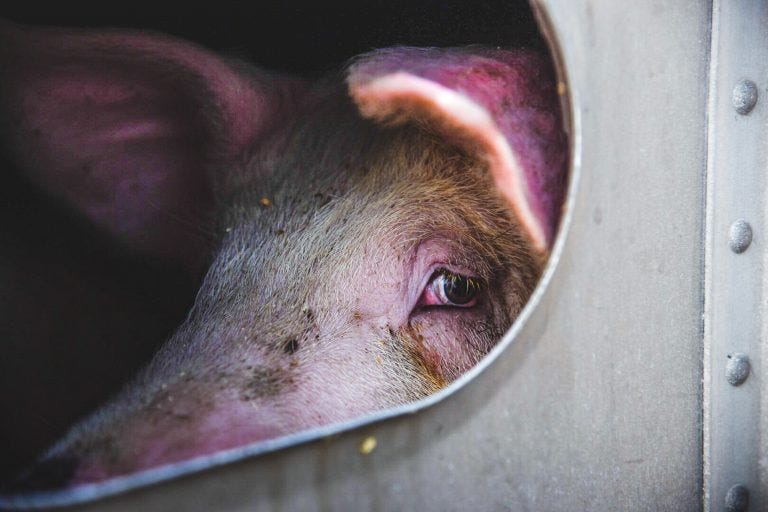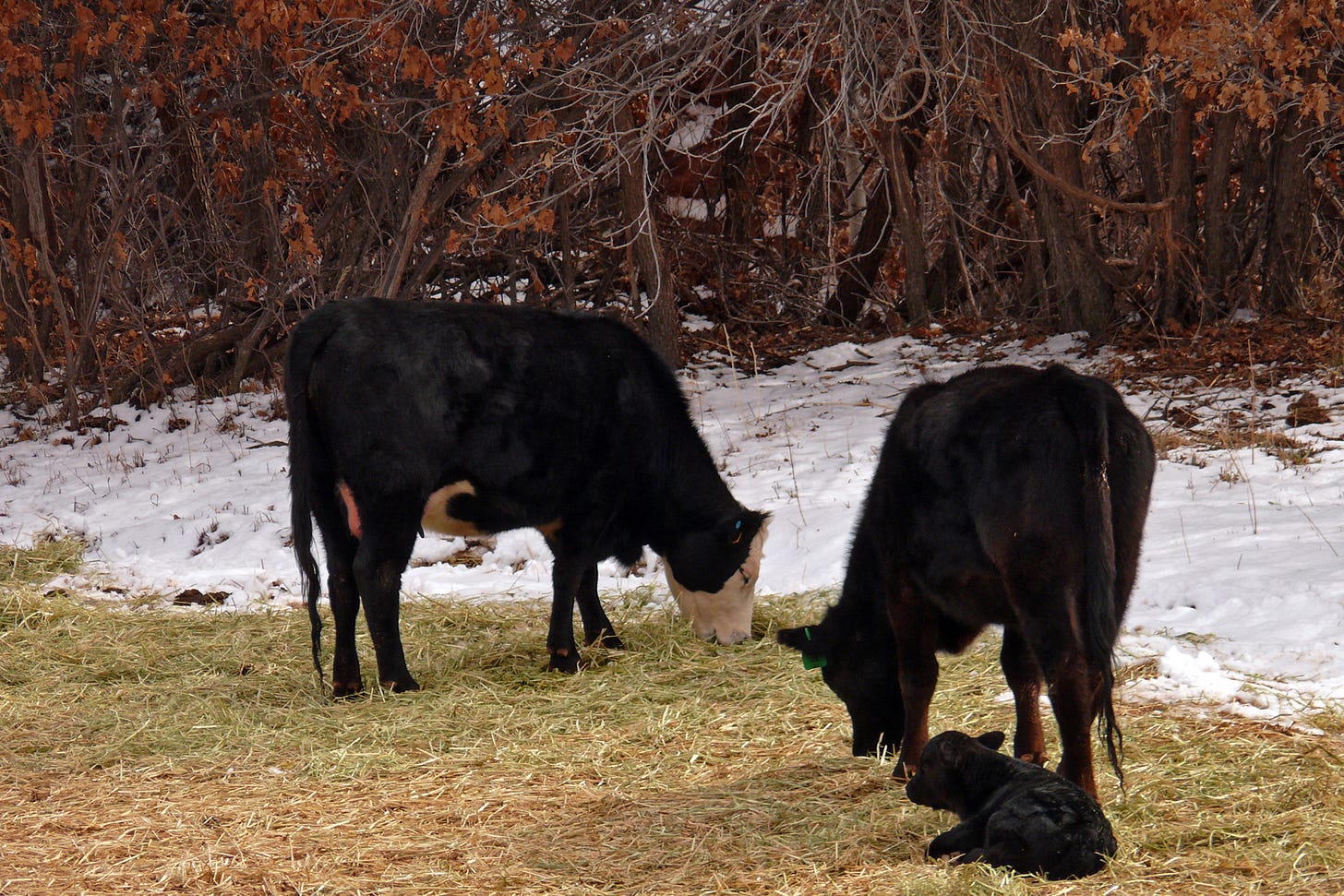Bird flu. H5N1. Avian Influenza. According to the Center for Disease Control (CDC), 92,343,826 cases of highly pathogenic avian flu have been detected in U.S. wild aquatic birds, commercial poultry, and backyard flocks since the beginning of the outbreak in 2022. Because the virus is so contagious, once a sick bird has been discovered in a chicken or turkey farm, they all have to be killed (or “culled”, as it’s called in the euphemistic meat industry lingo). As I wrote in May of 2022, shortly after the first cases were detected, some 37 million chickens had already been exterminated, in a horrifically cruel manner: with Ventilation Shutdown plus Heat, known as VSD+. It’s like sitting in a parked car in the summer with the windows rolled up, until you’re dead from heat stroke or you suffocate.
Avian flu has been back in the news because since March of this year some dairy cows have caught the virus, and as of today nine U.S. states have confirmed cases of infected cattle. Luckily, cows usually recover well and so far there haven’t been any mass exterminations. They don’t give any milk while sick, but according to the U.S. Department of Agriculture, the government will reimburse dairy farmers for 90% of the financial loss of milk production.

Pasteurized cow’s milk which is heated briefly to kill pathogens such as bacteria and to inactivate the H5N1 virus is considered safe for consumers. Incidentally, did you know that this process is named after the French chemist and microbiologist Louis Pasteur? He patented the process of pasteurization in 1865.
Raw milk can contain large quantities of the virus but its sale is prohibited on the federal level. Some states allow raw milk sales under certain conditions, but it’s illegal in most states. Why, then, are news agencies in a tizzy about cows that have the flu but recover nicely? Public health officials around the world are on high alert because the bird flu pathogen had always stayed with birds until quite recently. Somehow it has learned to jump to mammals, and if it manages to jump to humans – well, the fear of another pandemic is quite unsettling.
But all anybody cares about is humans. A recent New York Times article got me all mad. It clearly showed what all the articles about cows infected with avian flu focus on: there is a small chance that the virus jumps and makes people sick. As of May 22, the CDC reported two cases of H5 bird flu tied to the outbreak in dairy cows which was first discovered in March. Both times, a worker at a dairy farm got infected, the first one in Texas and the latest in Michigan. Both times, the individuals reported eye irritations (conjunctivitis) and no other symptoms. The CDC’s risk assessment for the general public remains low.
The NYT article was particularly irritating because it focused on one aspect which helped to spread the avian flu virus from the Texas Panhandle where the first infected cow was found to eight other states, as far away as Idaho, Michigan, and North Carolina: ground transportation, or live animal transport.

The article briefly describes the transportation process which moves cattle, chickens, and pigs all across the country, for up to 28 consecutive hours, crammed together. There’s one brief paragraph dedicated to the wellbeing of the animals, describing the physical toll they have to endure: exposed to extreme heat and cold, no break for water or food and no veterinary care. But the main focus of the article is the risk of disease transmission: stressed animals are more likely to get sick and pose a bigger danger to humans.
While the author of the NYT article, Emily Anthes, claims that “[t]here is virtually no data about how many get sick or die from the journeys”, British daily newspaper The Guardian did better research in 2022 and found that “[a]pproximately 20 million chickens, 330,000 pigs and 166,000 cattle are dead on arrival, or soon after, at abattoirs in the US every year, analysis of publicly available data shows. A further 800,000 pigs are calculated to be unable to walk on arrival.”1 20 million = 20,000,000. Of the 9 billion – 9,000,000,000 – chickens slaughtered in the U.S. every year, 20 million birds die during the transport.
How one can write about animal transport and only focus on the fact that it may pose a remote possibility of making people slightly sick is a perfect example for the unsustainable way we humans live on the Earth. It mirrors the extreme ego-centeredness that so many display these days: “I have the right to buy and carry a semi-automatic rifle”; “I have the right to refuse wearing a mask during a pandemic”; “I have the right to fly my private jet all over the place despite its CO2 emissions”; “I have the right to kill wild animals in Africa because I like trophies” – you get the picture. On a small scale, this is exactly what humanity does on a large scale: “We humans have the right to extract non-renewable fossil fuels, to cut down the Rainforest, to cruelly exploit animals. We humans are what matters on Earth, everything else is there for us to manipulate and utilize”. More precisely, humanity dominated by Western culture thinks this way, based on a Christian doctrine of a male God who created the Earth as well as the first (male) human who was put in charge of and given dominion over the rest of creation.
Native American cultures, by contrast, saw themselves as stewards and guardians of fellow non-human creatures that were more like relatives, brothers and sisters, rather than objects. We need a similar view if we want to prevent a climate catastrophe: a lateral instead of hierarchical view, a worldview which is based on cooperation instead of competitiveness, “the survival of the fittest”. Such a radical shift is possible; philosopher of science Thomas Kuhn called it a “paradigm shift” in The Structure of Scientific Revolutions. Think of the Copernican Revolution which eventually changed our model of the universe: from the Earth at its center, with the Sun and other planets circling around it, it changed to the Sun being at the center and the Earth circling around it, to the continually expanding spacetime continuum which doesn’t have an edge or a center: our Universe.
Such a shift requires a change in thinking and subsequently, perception: as human beings, we have to accept that other beings have their own worldviews; a tree, a fish, a rabbit each have their own worldview. They all live in a world that is complete and makes sense to them, but is more or less different from ours. All of these worldviews, including the human one, are incomplete. They’re all connected, and the more we humans come to realize this, the more we will FEEL the pain we cause. Then we can choose to stop the behavior that inflicts pain.








